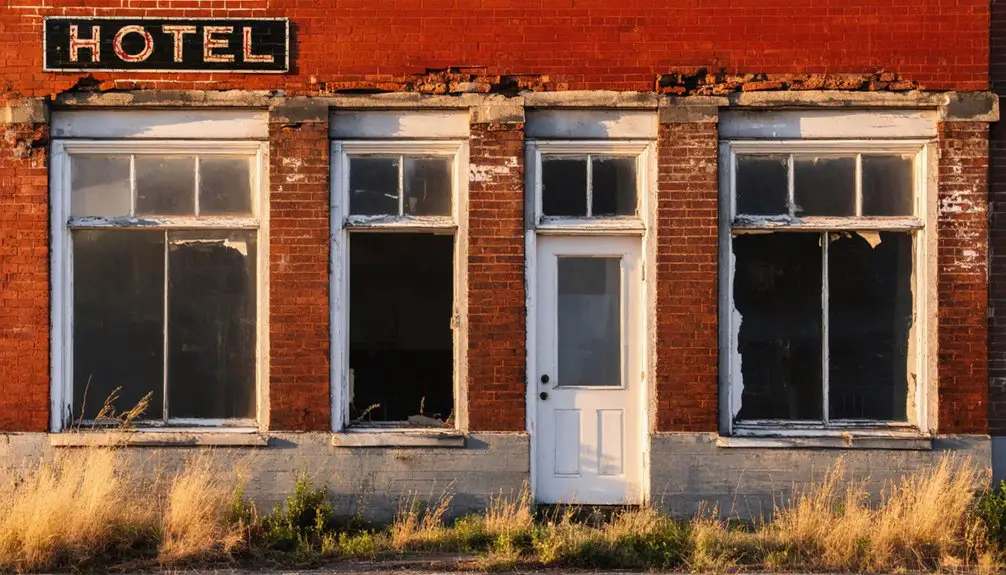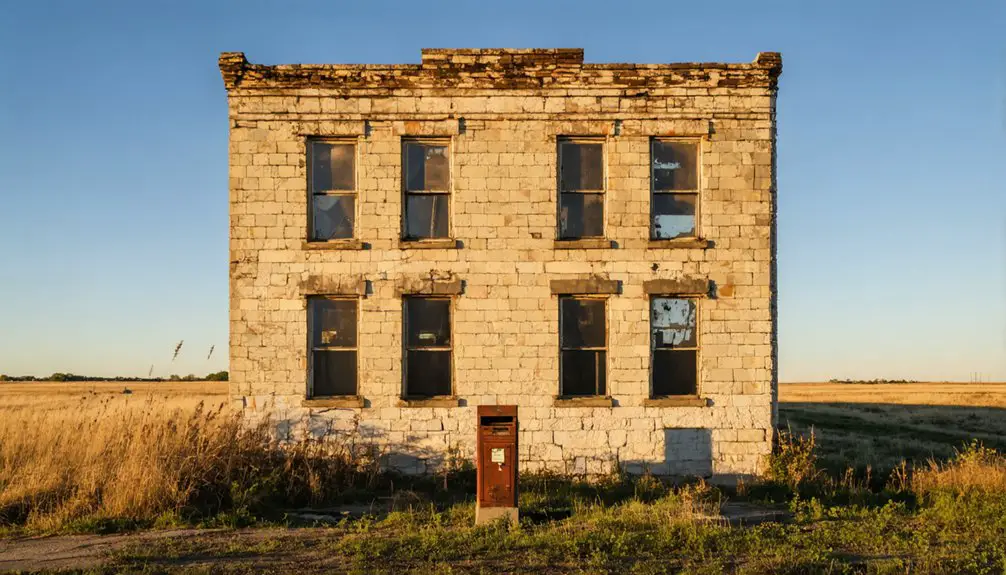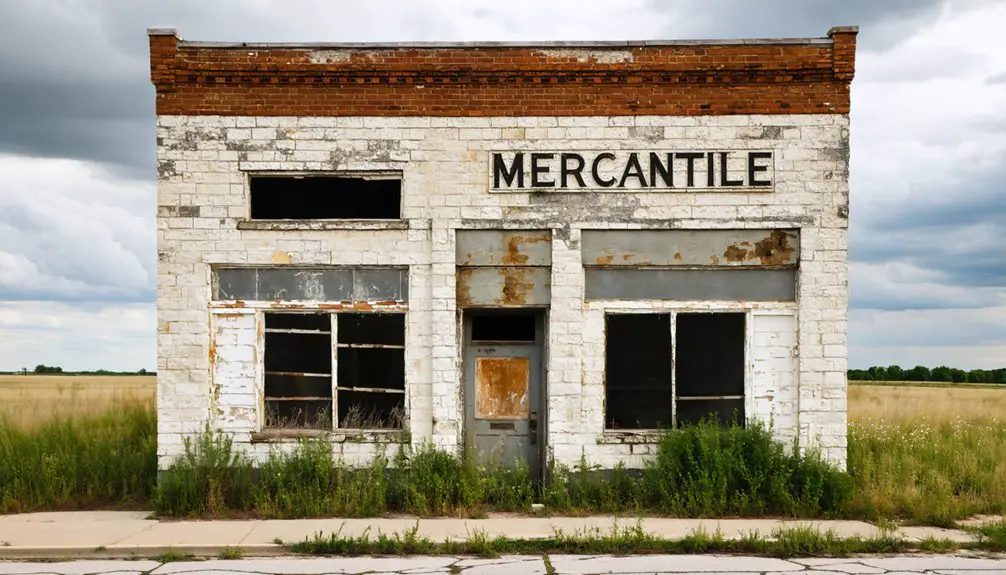You’ll find Brookville, Kansas, just west of Salina, where the Kansas Pacific Railroad‘s 1867 arrival transformed a frontier outpost into a thriving hub of 800 residents. The town boasted a roundhouse, shops, and the famous Brookville Hotel until economic decline struck in 1889 when the railroad relocated. Today, this shifting ghost town maintains its frontier charm with historic sandstone buildings, unpaved streets, and around 250 residents who keep its rich pioneer spirit alive.
Key Takeaways
- Brookville became a ghost town after its railroad roundhouse relocated to Junction City in 1889, causing population to drop from 2,000 to 200.
- The town is classified as a shifting ghost town with 247 residents as of 2020, primarily serving as a bedroom community for Salina.
- Historic sandstone buildings remain intact, with structures like the old school and Mercantile building repurposed for modern use.
- Unpaved streets and frontier-era architecture preserve the town’s historic character despite its diminished population and economic activity.
- The town maintains basic services including an active post office, churches, and school district despite its ghost town classification.
Railroad Origins and Town Establishment
When the Kansas Pacific Railroad tracks reached the area in 1867, they sparked the birth of what would become Brookville, Kansas.
John Crittenden, the first permanent settler, witnessed the railroad company’s strategic vision unfold as they built a roundhouse and shops that would serve as the heart of the new settlement. The early settlement faced Indian attacks as railway expansion disrupted native territories.
These initial structures drew more settler experiences to the area, creating a growing community along the east-west main street that paralleled the tracks. In 1873, Brookville reached a significant milestone when it was officially incorporated as a city.
Early Frontier Conflicts and Native American Raids
You’ll discover that Brookville’s first major clash with Native Americans occurred in 1867, when the Kansas Pacific Railroad’s westward expansion into traditional hunting grounds sparked intense tribal resistance. This conflict coincided with Hancock’s War that had erupted across Western Kansas.
The region had long been inhabited by the Wichita and Pawnee tribes before European settlement began. Warriors targeted the town’s crucial railroad infrastructure, specifically attempting to burn down the roundhouse where settlers and railroad workers had barricaded themselves for protection.
The town’s fate changed when a steam locomotive crashed through the roundhouse doors, frightening away the attackers and preserving Brookville’s foothold on the frontier.
Railroad Triggers Tribal Conflict
As the Kansas Pacific Railroad expanded westward in the 1850s and 1860s, it sparked intense conflicts with Native American nations who held legitimate land titles through existing treaties.
You’ll find that railroad companies often used deceptive practices to obtain rights of way through tribal lands, purchasing property below value and making false promises about enhanced land worth. Much like the families chronicled in A Question of Freedom, these Native American tribes fought to preserve their rights and sovereignty against an encroaching system.
The railroad’s presence heightened tribal tensions in Brookville when it was established in 1867. Like many conflicts during the colonial period, relations between settlers and tribes had initially been peaceful until competition for resources intensified.
Native warriors, defending their ancestral hunting grounds, launched a fierce attack on the settlement. Settlers barricaded themselves in the railroad roundhouse while warriors attempted to burn it down with railroad ties.
The conflict ended when a railroad crew broke through using a steam engine, forcing the Native attackers to retreat, with one warrior tragically caught in the train’s wheels.
Roundhouse Under Siege
During the tense summer of 1867, Native American warriors launched a fierce assault on Brookville’s newly constructed railroad roundhouse, forcing settlers to barricade themselves inside the sturdy stone structure.
The roundhouse defense proved critical as warriors, angered by railroad expansion into their hunting grounds, surrounded the building and attempted to set it ablaze using piled railroad ties.
You’d have witnessed the dramatic conclusion when quick-thinking railroad workers used a steam engine to burst through the roundhouse doors, causing the attackers to scatter.
The siege marked one of the earliest violent clashes between settlers and Native tribes in Brookville, highlighting the growing tensions over territorial expansion.
The native tactics of surprise raids and fire warfare would continue to challenge railroad development, though the roundhouse remained a symbol of settler resilience.
Steam Engine Saves Town
When warriors surrounded the Brookville roundhouse in 1867, a resourceful steam engine crew turned their locomotive into an unexpected weapon of defense.
During this time, the Chisholm Trail was bringing increased frontier traffic and tensions to the Kansas territory.
As Native American raiders pressed closer to the railroad structure where townspeople had taken refuge, quick-thinking engineers devised one of the most innovative steam engine defenses of the frontier era.
You can imagine the scene: the massive locomotive bursting through the roundhouse doors in a thunderous display of steam and steel, startling the attackers and forcing them to retreat.
The expansion of steam pressure provided the powerful force needed to drive the locomotive forward and scatter the raiders.
This creative use of the steam engine didn’t just save lives that day – it established a new blueprint for frontier innovations in settlement defense.
The incident demonstrated how the railroad’s presence provided more than just transportation; it gave communities like Brookville the tools to protect their hard-won freedom on the frontier.
Economic Prosperity and Business Growth
Once the Kansas Pacific Railroad arrived in 1870, Brookville transformed into a bustling commercial hub with a thriving cattle shipping operation that attracted ranchers and cowboys from across the region.
You’d find economic factors driving growth everywhere – from four general merchandise stores to flour mills and wagon repair shops. Like other Kansas cowtowns, Brookville drew rough crowds seeking entertainment and vice in its establishments. The town’s business diversity exploded as the population reached 600 to 800 residents by the early 1880s. Much like Empire City’s growth, saloons and gambling halls emerged as the population rapidly expanded.
As a Union Pacific division point, Brookville supported multiple hotels, banks, and newspapers. You could shop at boot stores, jewelers, or milliners, then spend evenings in dance halls and saloons.
Churches and schools balanced the town’s wilder side. This prosperity continued until 1889, when the railroad’s roundhouse relocated to Junction City, marking the beginning of Brookville’s economic decline.
The Legendary Brookville Hotel Legacy

The Brookville Hotel’s legendary status began in 1894 after Gus and Mae Magnuson purchased the establishment, setting in motion a family legacy that would span generations.
Their daughter Helen Martin stepped in during 1914, later becoming proprietor in 1933. She’d create the hotel’s signature family-style chicken dinners that put Brookville on the map.
You’ll find the heart of their success rooted in traditional family recipes – from crispy fried chicken to creamy mashed potatoes with gravy.
During WWII, soldiers from nearby bases made the hotel their home away from home.
While recent hotel renovations stalled and led to its removal from the National Register in 2014, the Martin family continued serving their beloved dishes in Abilene until 2020, when the pandemic forced their doors to close.
Natural Disasters and Economic Hardships
During Brookville’s most turbulent period in the late 19th century, a series of devastating events shook the community to its core.
You’d have witnessed an Indian attack in 1867, when warriors attempted to burn the roundhouse but were driven back by determined railroad workers. A fierce blizzard later threatened the town’s survival, testing the resilience of its people.
The most crushing blow came on Christmas Eve 1890, when a devastating fire destroyed the Central Hotel, the local bank, and several homes.
On that fateful Christmas Eve, flames ravaged Brookville’s heart, claiming the Central Hotel, bank, and neighboring homes.
This natural disaster coincided with severe economic decline as the railway division point relocated, eliminating vital jobs. The 1890s depression followed, forcing many residents to seek opportunities elsewhere.
The town’s population plummeted from 2,000 to less than 200, marking Brookville’s transformation into a ghost town.
Population Changes Through the Decades

Since Brookville’s official establishment by the Kansas Pacific Railroad in 1870, you’d have witnessed dramatic population swings that shaped the town’s destiny.
Starting with 201 residents, the population soared to 511 by 1880, marking the town’s peak during its railroad heyday. You’d then see a sharp decline to 345 residents by 1890, as fires, blizzards, and economic hardships drove people away.
Throughout the 20th century, you’d notice population stability settling in, with numbers hovering between 213 and 262 residents.
Today’s Brookville shows continuing demographic shifts, with 247 residents as of 2020 and a median age of 51.2 years. While the community remains chiefly White, you’ll find a small but growing multiracial presence, reflecting subtle changes in this historic railway town.
Transportation Hub and Railway Impact
When Brookville became a division point for the Union Pacific Railroad in 1867, you’d have seen a bustling operation with a roundhouse and repair shops forming the town’s core infrastructure.
You’d find railroad workers and their families settling into the growing community, building homes and establishing local businesses to serve the railway operations.
The town’s economic importance directly stemmed from its role as a transportation hub, with numerous shops, hotels, and services catering to the steady stream of railway personnel and travelers.
Railroad Division Point Operations
After the Union Pacific Railroad designated Brookville as a division point in 1870, the town transformed into an essential transportation hub along the Kansas Pacific main line between Kansas City and Denver.
The railroad infrastructure included a roundhouse, repair shops, and workshop facilities that served as crucial maintenance centers for locomotives and railroad ties. You’d find freight depots and water facilities supporting the steam engines that powered through town.
The division point status attracted diverse businesses, from hardware stores to flour mills, while creating jobs in maintenance and logistics. As a shipping center, Brookville connected local ranchers and farmers to national markets.
However, the town’s prosperity wouldn’t last forever. Following fires, blizzards, and economic depressions, Brookville experienced severe economic decline when it lost its division point status in the 1890s.
Railway Worker Community Growth
As the Kansas Pacific Railroad tracks reached Brookville in 1867, a vibrant railway worker community sprang to life around the newly constructed roundhouse and repair shops.
You’d have witnessed skilled railroad labor transforming the empty prairie into a bustling settlement, with workers quickly establishing homes, businesses, and essential services.
The community dynamics evolved rapidly as the population swelled to 800 residents.
Swedish immigrants joined the workforce, adding cultural diversity to the growing town.
You’d have found a thriving mix of permanent settlers and railway personnel creating a close-knit society, supported by new hotels, restaurants, and stores.
The town’s social fabric centered on railroad operations, with workers and their families establishing deep roots in this transportation hub.
Telegraph offices, banks, and a newspaper soon followed, marking Brookville’s transformation into a proper railway town.
Notable Historical Buildings and Structures

The bustling railroad town of Brookville featured several significant structures that shaped its identity during the late 1800s.
You’ll find that the Kansas Pacific Railroad’s roundhouse and shops, built in 1867, served as the town’s first historical architecture and provided refuge during Indian attacks.
The Brookville Hotel, also known as the Central Hotel, became a cherished community landmark until fire claimed it in 1890.
Around the commercial district, you’d have seen George Snyder’s store, established after the 1870 town layout, alongside hardware stores and wagon shops.
The brick Brookville Mercantile building stood out with its distinctive dual windows and rooftop signage.
M.P. Wyman’s house, built in 1870, marked the beginning of residential development, though many wooden structures succumbed to the devastating 1890 fire.
Cultural Significance in Kansas History
You’ll find Brookville’s most enduring cultural impact in its role as a pivotal Kansas Pacific Railroad town, where the pioneer spirit transformed raw prairie into a bustling transportation hub.
The town’s resilience through Native American conflicts and natural disasters has become emblematic of frontier determination in Kansas history.
The legacy of the famous Brookville Hotel, known for its family-style chicken dinners served from 1870 until its relocation to Abilene in 2000, continues to keep the town’s memory alive in Kansas culinary culture.
Railroad Heritage Impact
Railroad heritage runs deep through Brookville’s cultural identity, stemming from its 1867 establishment when Kansas Pacific Railroad tracks first carved through the region.
You’ll find that railroad innovation transformed this Kansas prairie into a bustling division point, where roundhouses and shops sparked economic importance. The town’s spirit of community resilience emerged through challenges, from Native American conflicts to natural disasters, yet the railroad remained central to local life.
As a reflection of this heritage, you can trace how the railroad shaped everything from family histories to local businesses like the iconic Brookville Hotel.
While the town’s population has dwindled to fewer than 200, its railroad legacy lives on as a powerful reminder of Kansas’s pioneering spirit and the transformative impact of westward expansion.
Pioneer Spirit Lives On
Determination and grit marked Brookville’s founding in 1867, when pioneer John Crittenden led early settlers to establish roots alongside the expanding Kansas Pacific Railroad.
You’ll find pioneer resilience woven throughout Brookville’s story – from settlers facing Native American conflicts to rebuilding after the devastating 1890 fire that destroyed their town center.
Even as hardships mounted, including harsh blizzards and economic depression, the community’s identity remained strong through local businesses, social gatherings, and the iconic Brookville Hotel.
Though the town eventually declined, you can still witness its enduring spirit in the preserved cultural landmarks and stories passed down through generations.
The hotel’s relocation to Abilene and Helen Martin’s family-style dining tradition showcase how Brookville’s pioneer heritage continues to influence Kansas culture today.
Dining Tradition’s Cultural Legacy
While many ghost towns fade into obscurity, Brookville’s cultural legacy lives on through its iconic dining tradition established at the Brookville Hotel.
You’ll find its roots in Helen Martin’s early 20th-century vision, which transformed a simple family business into a renowned regional institution. The hotel’s dining customs centered around hearty, communal meals that embodied Midwestern pioneer values and local hospitality.
During World War II, soldiers from nearby military bases helped spread Brookville’s reputation for exceptional family-style dining.
Even as the town’s population dwindled and the railroad’s importance declined, these shared meals continued to unite the community.
Today, you can experience this preserved heritage at the relocated Brookville Hotel in Abilene, where the tradition serves as a living connection to Kansas’s pioneer spirit and railroad town history.
Present-Day Ghost Town Status
Although Brookville once bustled with nearly 2,000 residents in the 1870s, today’s population of 247 reflects its status as a shifting ghost town.
Despite the dramatic population decline, you’ll find a resilient community that’s adapted to modern times while preserving its historic character.
You can see this blend of past and present throughout town. The old sandstone buildings remain intact, though they’ve taken on new purposes – the historic school is now a private residence, and the Mercantile building serves as the Sandstone Saloon.
While the unpaved streets maintain their frontier-era charm, Brookville functions primarily as a bedroom community for nearby Salina.
With its active post office, functioning churches, and operating school district, Brookville stands as more of a fading town than a true ghost town.
Frequently Asked Questions
Are There Any Remaining Original Buildings Still Standing in Brookville Today?
You’ll find several rad original buildings rocking the streets today, including the stone schoolhouse, Mercantile-turned-Sandstone-Saloon, two churches, and post office – all showcasing historical preservation of authentic architecture.
What Happened to the Native American Tribes After the 1867 Attack?
After the 1867 attack, you’ll see Native Displacement forced tribes onto reservations, losing their hunting grounds and freedom. Despite hardships, they maintained Cultural Resilience through political resistance and preservation of traditions.
Did Any Famous Historical Figures Ever Visit or Stay in Brookville?
While you might expect famous visitors given its historical significance as a railroad stop, there aren’t any documented cases of notable historical figures staying in Brookville during its heyday.
What Was the Average Land Price During Brookville’s Peak Development Period?
You’d find land values during the 1870s-1880s peak ranging from $2 to $5 per acre, with prime commercial lots near the railroad commanding higher prices during the period of economic growth.
Were There Any Documented Paranormal Activities in Abandoned Brookville Buildings?
Peculiar but possible, you won’t find documented paranormal sightings or ghost stories in Brookville’s buildings. Despite its ghost town status and violent history, there’s no credible evidence of supernatural activity.
References
- https://www.legendsofamerica.com/ks-brookville/
- https://lostkansas.ccrsdigitalprojects.com/sites/lostkansas/files/private_static/2022-12/LT_SA_Brookville_Shaw.pdf
- https://postcardhistory.net/2021/09/the-brookville-hotel/
- https://legendsofkansas.com/kansas-ghost-town-list/
- https://www.legendsofamerica.com/ks-ghosttowns/
- https://salina311.com/beyond-the-city-limits-4/
- https://www.ksgenweb.org/archives/1912/b/brookville.html
- https://www.kancoll.org/books/cutler/saline/saline-co-p9.html
- https://legendsofkansas.com/kansas-time-line/
- https://truewestmagazine.com/article/hancocks-war/



